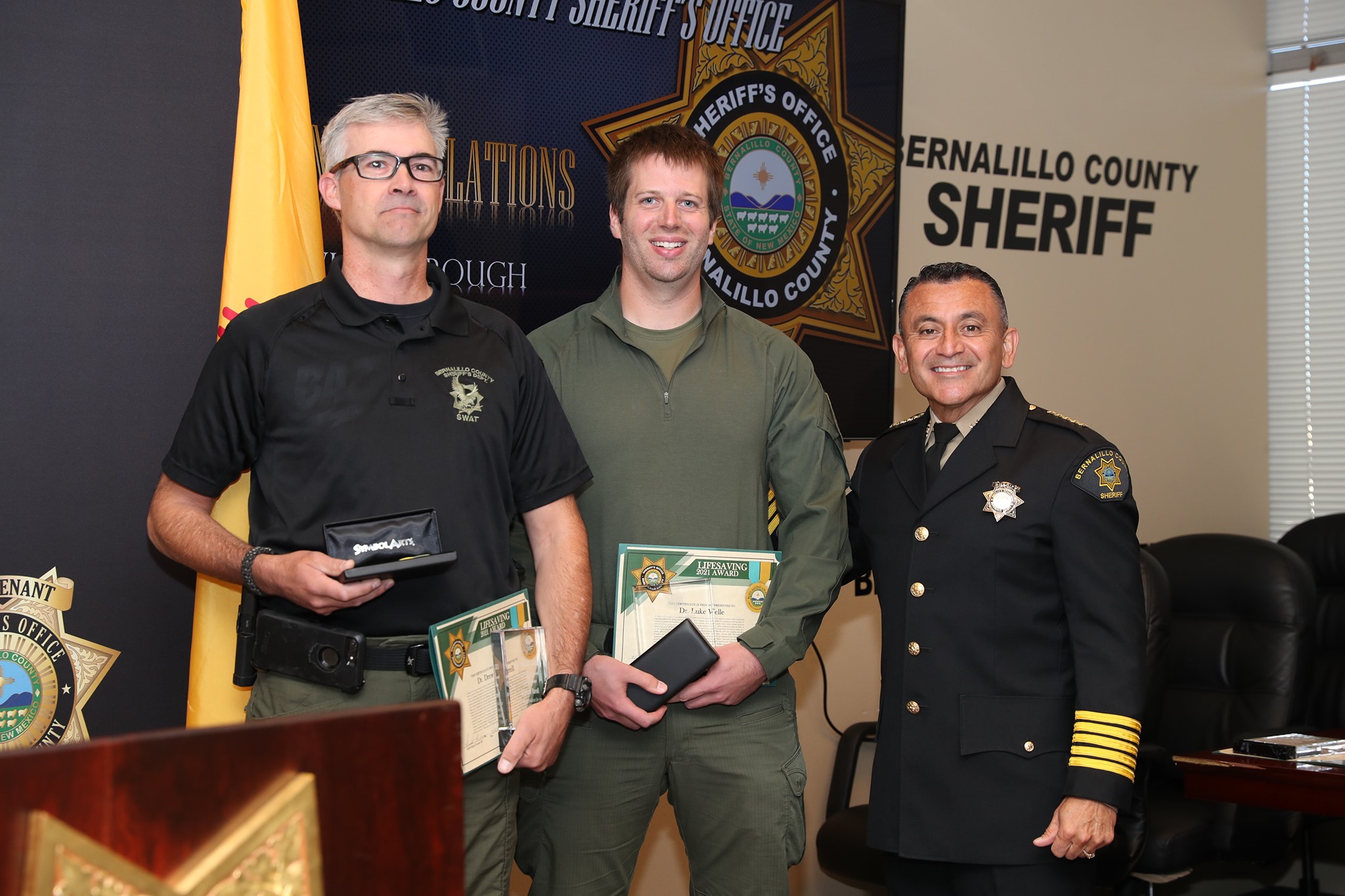Preparing for Disaster: UNM Hospital Participates in Region-Wide Emergency Training

Critical Conditions
UNM Tactical Emergency Medical Services Doctors Team Up With Law Enforcement to Provide On-Scene Life-Saving Care
What began as a SWAT callout turned into a medical emergency. Fortunately, two University of New Mexico emergency physicians were on hand to perform life-saving measures.
It’s not because they happened to be in the area of the police activity. It’s because they are part of the Dr. George Kennedy Center for Law Enforcement Operational Medicine within the UNM Emergency Medical Services (EMS) Consortium, in which emergency physicians and paramedics provide life-saving support at particularly dangerous scenes.
The center was formally established in 2020, though a handful of UNM doctors have been assisting local law enforcement for about 25 years. The late Kennedy, for whom the center is named, spent most of his career supporting law enforcement and developing Tactical Emergency Medical Services (TEMS) at UNM, says center director Drew Harrell, MD.
Harrell and EMS fellow Luke Welle, MD, recently received an award from the Bernalillo County Sheriff’s Office lauding them for saving a pregnant woman’s life at the SWAT call.
In early August, a couple who were wanted on felony warrants had barricaded themselves in an apartment, according to a BCSO letter of commendation. While negotiations continued between sheriff’s deputies and the couple, the woman overdosed and was unresponsive.
BSCO then forced entry in their home, enabling Harrell and Welle to administer Narcan, a medication that rapidly reverses opioid overdoses, and perform bag-to-mouth respiration, because she wasn’t breathing. After the woman was stabilized, she was taken to the hospital.
“Without having the SWAT medical personnel on scene, this likely would have been a very different outcome,” the commendation letter says. “The SWAT doctors informed me without hesitation that (the woman’s) life was indeed in great peril and the overall actions saved her life.”
Had the deputies had to wait for an ambulance to arrive, the woman likely wouldn’t have survived, Harrell said.
“It's a testament to and really an award for everybody there,” Harrell says. “We were provided an opportunity to do something really beneficial. We were successful because we were put in a position where everything had been handled appropriately. It's easy to succeed when you're put in a spot that's prepared for you to do (well).”
TEMS physicians and paramedics receive specialized training from law enforcement partners so that they know the protocol at the scene. They wear body armor, and instead of staging a few blocks away, they’re right in there with police.
TEMS differs from other paramedic teams in that it’s indistinguishable from the officers, so they can function cohesively, Harrell explains.
“We are located alongside (officers), and it requires a lot of ongoing training and acceptance of having (the EMS team) there,” Harrell says.
Jacob Debevec, program coordinator for the Division of Prehospital, Austere & Disaster Medicine, says the on-scene services are designed to supplement the existing EMS system.
“In some of the communities across the state, there is no EMS system to provide this care,” he says, adding that even within the Albuquerque metro area EMS services are stretched thin.
In addition to being on-call 24/7 for crime scene callouts, TEMS physicians also work in the UNM Hospital Emergency Department.
Kennedy and Gregg Solove, MD, an anesthesiologist, started the effort years ago, Harrell says. Today, the TEMS team includes Solove, Mateo Garcia, MD, and 10 paramedics.
TEMS has been dispatched to 40-50 callouts this year for BCSO, and about 200 involving other agencies.
“It’s been very busy,” Harrell says.
The UNM School of Medicine’s EMS Consortium has had a longstanding relationship with the Bernalillo County Sheriff’s Office, and more recently has provided medical services to Rio Rancho Police Department and New Mexico State Police, says Harrell, who has been involved in providing medical services for law enforcement for 15 years. The center also provides ongoing life-saving training to law enforcement and other medical professionals.
“As far as the medical care goes, we're both emergency physicians,” Welle says. “We see stuff like this in the Emergency Department every day. The medical care is very similar. It's just in a different environment.”
The team often travels to the far reaches of the state to assist the State Police in areas where medical care for trauma victims isn’t available.
“The importance of being well-integrated into law enforcement agencies’ special operations teams requires a lot of ongoing training, because you need to build the skills and the acceptance of the individuals that you're supporting so that they are comfortable knowing that you know what to do in certain situations,” Harrell says. “It's a unique environment for medical professionals of any level of training to be operating in.”
Whether the scene involves an overdose, a shooting or another traumatic injury, “there's a finite window” for saving a life, Harrell says. “I think that really speaks to the benefit of close medical support for law enforcement operations, which is really what we focus on within the center.”